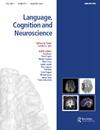规划句子生成中的多个依赖关系
IF 1.8
3区 医学
Q2 AUDIOLOGY & SPEECH-LANGUAGE PATHOLOGY
引用次数: 1
摘要
本文章由计算机程序翻译,如有差异,请以英文原文为准。
Planning multiple dependencies in sentence production
ABSTRACT One of the defining properties of human language is the abundance of potentially unbounded dependencies between elements in a sentence. And yet, how speakers formulate dependencies in sentence production is still poorly understood. Here we examine the timing of verb planning in sentences involving across-the-board and parasitic gap constructions. Using a new task we call the Sentence-Word Interference task, we show that speakers plan the verb of a secondary clause before sentence onset, but selectively when producing across-the-board sentences and not when producing parasitic gap sentences. Based on this timing contrast, we argue that speakers plan verbs predominantly before the production of their dependents, but only when verbs and their dependents engage in both conceptual and direct syntactic relationships. More broadly, the current study suggests that sentence planning is constrained by syntactic relationships that are not reducible to conceptual relationships or to surface word order.
求助全文
通过发布文献求助,成功后即可免费获取论文全文。
去求助
来源期刊

Language Cognition and Neuroscience
AUDIOLOGY & SPEECH-LANGUAGE PATHOLOGY-BEHAVIORAL SCIENCES
CiteScore
4.50
自引率
13.00%
发文量
70
期刊介绍:
Language, Cognition and Neuroscience (formerly titled Language and Cognitive Processes) publishes high-quality papers taking an interdisciplinary approach to the study of brain and language, and promotes studies that integrate cognitive theoretical accounts of language and its neural bases. We publish both high quality, theoretically-motivated cognitive behavioural studies of language function, and papers which integrate cognitive theoretical accounts of language with its neurobiological foundations.
The study of language function from a cognitive neuroscience perspective has attracted intensive research interest over the last 20 years, and the development of neuroscience methodologies has significantly broadened the empirical scope of all language research. Both hemodynamic imaging and electrophysiological approaches provide new perspectives on the representation and processing of language, and place important constraints on the development of theoretical accounts of language function and its neurobiological context.
 求助内容:
求助内容: 应助结果提醒方式:
应助结果提醒方式:


